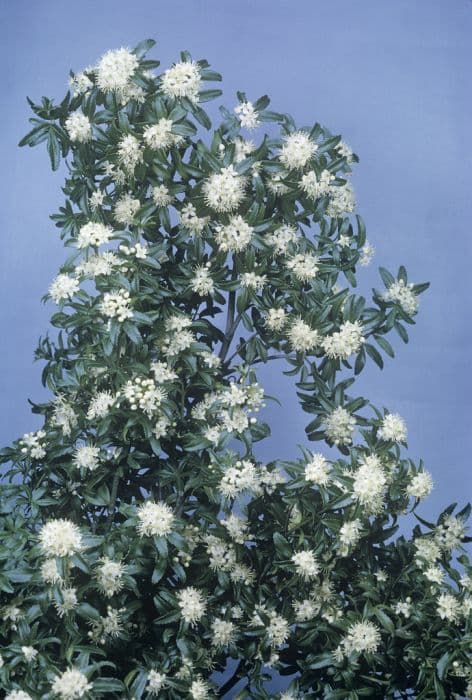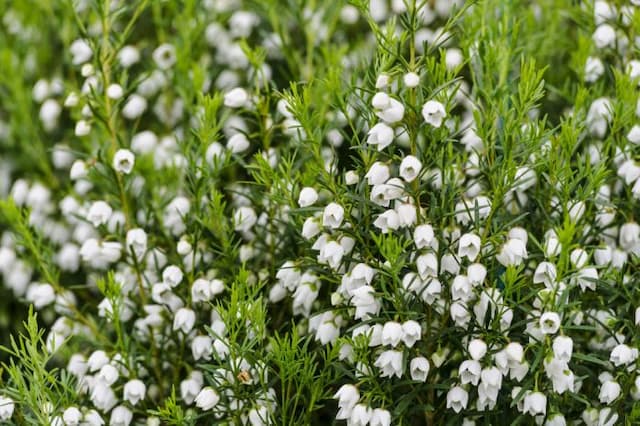Kew Green Skimmia Skimmia × confusa 'Kew Green' (m)

ABOUT
Skimmia 'Kew Green' is an evergreen shrub that is notable for its glossy, dark green leaves which have a leathery texture. The foliage grows in a dense, compact manner and can provide year-round interest in a garden setting. Throughout the growing season, the leaves maintain their lustrous appearance, creating a backdrop for the other distinctive feature of the plant, its flowers. The shrub produces clusters of small, fragrant flowers. These blooms have a creamy-white color and are quite aromatic, which can add a pleasant scent to the surrounding area. The flowers are star-shaped and grow in conical clusters at the ends of the branches, which adds a decorative appeal to the shrub. After the flowering period, Skimmia 'Kew Green' may produce berries if a suitable pollinator variety is nearby. The berries can provide additional visual interest, usually appearing in a shade of red and contrasting nicely against the dark green foliage. However, as a male cultivar, Skimmia 'Kew Green' itself does not bear fruit but is necessary for pollination of female Skimmia plants. This plant is appreciated for its robustness and the dense, lush appearance it maintains throughout the seasons, making it a popular choice for gardeners looking to add evergreen structure to their landscapes. Its small, fragrant flowers and potential contribution to berry production in female Skimmias are added bonuses that enhance its ornamental value.
About this plant
 Names
NamesFamily
Rutaceae
Synonyms
Kew Green Skimmia, Japanese Skimmia
Common names
Skimmia × confusa 'Kew Green' (m).
 Toxicity
ToxicityTo humans
Skimmia 'Kew Green' is considered to be mildly toxic to humans. If ingested, parts of the plant can cause symptoms such as nausea, vomiting, abdominal pain, and diarrhea. The berries are particularly toxic, and consuming them can lead to more severe symptoms, including respiratory difficulties and an increased heart rate. Children are more susceptible to the toxic effects due to their smaller body size. It is advisable to seek medical attention if ingestion occurs, especially in the case of children and individuals with a weakened immune system.
To pets
Skimmia 'Kew Green' is toxic to pets as well. If animals, such as dogs or cats, ingest any part of the plant, they may exhibit symptoms including vomiting, diarrhea, weakness, and abnormal heart rate. The berries are particularly poisonous and can cause more intense reactions if consumed by pets. It is important to prevent pets from having access to this plant and to consult a veterinarian immediately if ingestion is suspected.
 Characteristics
CharacteristicsLife cycle
Perennials
Foliage type
Evergreen
Color of leaves
Green
Flower color
White
Height
3 feet (0.91 meters)
Spread
3 feet (0.91 meters)
Plant type
Shrub
Hardiness zones
7
Native area
Asia
Benefits
 General Benefits
General Benefits- Year-round Interest: Offers evergreen foliage, maintaining its appearance throughout the seasons.
- Winter Blooms: Produces clusters of small, fragrant white flowers in late winter or early spring, brightening up the garden when few other plants are in bloom.
- Low Maintenance: Requires minimal pruning and care once established, making it suitable for gardeners of all skill levels.
- Drought Tolerant: Once established, has a good level of drought resistance, reducing the need for frequent watering.
- Shade Tolerant: Grows well in partial to full shade, ideal for understory planting or north-facing gardens.
- Attractive to Wildlife: Flowers may attract pollinators, such as bees, enhancing biodiversity in the garden.
- Compact Growth: With its small to medium size, it fits well in urban gardens, borders, and containers.
- Deer Resistant: Generally not favored by deer, which can be beneficial in areas where deer browsing is a problem.
- Ornamental Berries: Female plants produce red berries, adding to its decorative appeal (Note: 'Kew Green' is a male clone and does not produce berries).
 Medical Properties
Medical PropertiesThis plant is not used for medical purposes.
 Air-purifying Qualities
Air-purifying QualitiesThis plant is not specifically known for air purifying qualities.
 Other Uses
Other Uses- Photography Prop: 'Kew Green' Skimmia, with its attractive green foliage and clusters of white flowers, can serve as a picturesque backdrop or focal point for garden photography.
- Insectary Plant: 'Kew Green' Skimmia can be planted to attract beneficial insects, such as hoverflies, that aid in pollination and natural pest control within the garden ecosystem.
- Feng Shui Plant: In the practice of Feng Shui, 'Kew Green' Skimmia might be used to harmonize and balance the flow of energy in a home garden with its evergreen presence and calming green hue.
- Container Gardening: As a compact and evergreen shrub, 'Kew Green' Skimmia is an excellent plant for container gardening, adding year-round interest to patios, balconies, or terrace gardens.
- Winter Garden Interest: Due to its hardiness and perennial nature, 'Kew Green' Skimmia provides visual interest in the winter garden when most other plants have died back or gone dormant.
- Miniature Gardens: The 'Kew Green' Skimmia can be included in miniature gardens or fairy gardens because of its small scale and dense foliage, which can mimic larger shrubs at a tiny scale.
- Floral Arrangements: The branches and foliage of 'Kew Green' Skimmia can be cut and used in floral arrangements, providing a lush, green canvas against which more colorful flowers can stand out.
- Cultural Festivals: In some cultures, 'Kew Green' Skimmia's evergreen leaves symbolize endurance and could be used during festivals as a token of resilience or longevity.
- Privacy Screening: When planted in a mass or as a hedge, 'Kew Green' Skimmia can act as a privacy screen, obscuring undesirable views or creating a natural boundary between different areas of the garden.
- Holiday Decor: The robust green foliage of 'Kew Green' Skimmia can be used in holiday wreaths and garlands, offering a fresh and natural look during festive seasons.
Interesting Facts
 Feng Shui
Feng ShuiThe Kew Green Skimmia is not used in Feng Shui practice.
 Zodiac Sign Compitability
Zodiac Sign CompitabilityThe Kew Green Skimmia is not used in astrology practice.
 Plant Symbolism
Plant Symbolism- Everlasting Affection: 'Kew Green' is an evergreen plant, symbolizing unending love or affection that persists through all seasons.
- Protection: Skimmia plants are often used in gardens to provide structure and shelter, symbolizing safety and security.
- Resilience: This plant is hardy and can thrive in various conditions, representing resilience and adaptability to life's challenges.
- Peace and Tranquility: The glossy green foliage and compact growth habit of 'Kew Green' can create a serene atmosphere, symbolizing calmness and peace.
- Festivity: Skimmia is popular for use in winter and Christmas decorations due to its evergreen nature and red berries (on the female plants), symbolizing celebration and joy.
 Water
WaterKew Green Skimmia should be watered thoroughly when the top inch of soil feels dry to the touch, which typically means once or twice a week during the growing season and less frequently during the winter. It is important to use lukewarm water and to apply it directly to the soil rather than spraying the leaves to prevent fungal diseases. Ensure the plant receives about 1 inch of water each week, either through rainfall or manual watering. During hot, dry periods, this may require about 0.5 gallons per square foot every week to maintain moisture, but be careful not to overwater as this can lead to root rot.
 Light
LightKew Green Skimmia thrives best in partial shade to full shade, where the plant is protected from the harsh rays of the full sun, particularly in the afternoon. The ideal spot would be under the canopy of tall trees providing dappled sunlight or on the north side of a building. These lighting conditions help to ensure that the foliage remains vibrant and the plant experiences healthy growth.
 Temperature
TemperatureKew Green Skimmia prefers moderate temperatures and is hardy in conditions that don't typically drop below 20 degrees Fahrenheit or exceed 80 degrees Fahrenheit. The ideal temperature range for this plant is between 60 and 75 degrees Fahrenheit. It can survive short periods outside of this range but may suffer damage from prolonged exposure to extreme cold or heat.
 Pruning
PruningPrune Kew Green Skimmia to remove any dead or damaged branches and to shape the plant, if necessary, but be aware that it's a slow grower and typically requires minimal pruning. The best time for pruning is in the late winter or early spring before new growth begins. Doing it at this time helps to prevent the loss of flower buds that form on the previous year's wood.
 Cleaning
CleaningAs needed
 Soil
SoilKew Green Skimmia thrives best in a soil mix that is rich in organic matter, moist, and well-draining. Ideally, the soil pH should be acidic, ranging between 5.5 and 6.5. A good mix might consist of equal parts peat, pine bark, and perlite or coarse sand to ensure proper drainage and a suitable acidic environment for this plant.
 Repotting
RepottingKew Green Skimmia should be repotted every two to three years to prevent becoming root-bound and to replenish the soil nutrients. The best time to repot is in the spring before the onset of the growing season.
 Humidity & Misting
Humidity & MistingKew Green Skimmia prefers moderate to high humidity levels, ideally around 50-60%. Avoid placing it in very dry environments, and if indoor air is dry, consider using a humidifier or placing the pot on a tray of moist pebbles to increase local humidity.
 Suitable locations
Suitable locationsIndoor
Place in bright, indirect light and ensure high humidity.
Outdoor
Plant in partial shade, sheltered from harsh winds.
Hardiness zone
7-9 USDA
 Life cycle
Life cycleSkimmia × confusa 'Kew Green', commonly known as Kew Green Skimmia, begins its life cycle when seeds germinate in spring, typically requiring a period of cold stratification to break dormancy. The seedlings develop into juvenile plants with characteristic glossy green foliage, initially forming a low mound of growth. As the plants mature, they produce robust, evergreen foliage and establish a dense, rounded shrub structure. Kew Green Skimmia reaches maturity in several years, at which point it produces fragrant white flowers in spring, followed by ornamental, but not edible, red berries if a female pollinator variety is present nearby. After the flowering and potential fruiting period, the plant enters a maintenance phase where it continues to grow slowly and may be pruned to shape. The lifespan of Skimmia × confusa 'Kew Green' can extend up to several decades with proper care and favorable conditions.
 Propogation
PropogationPropogation time
Spring-Early Summer
The Skimmia 'Kew Green,' an evergreen shrub known for its aromatic foliage and clusters of greenish-white flowers, is commonly propagated through semi-hardwood cuttings. This method is often conducted in late summer, once the spring growth has ripened slightly but the stem is not fully hardened. To propagate, a cutting of about 4 to 6 inches (10 to 15 centimeters) is taken, ensuring it has a few leaf nodes. The lower leaves are removed, and the cut end may be treated with rooting hormone to encourage root development. The cutting is then inserted into a moist, well-draining potting mix or a mixture of peat and perlite. The environment should be kept humid, often achieved by placing a plastic bag or a propagator over the cutting. With proper care, roots will develop in a few weeks, and the new Skimmia 'Kew Green' can be transplanted the following spring.


![Mexican orange [Sundance]](/_next/image?url=https%3A%2F%2Fplants-admin.emdemapps.com%2Fimages%2Fplants%2F%2Fimages%2F604b5381bcf0d.png&w=640&q=75)






